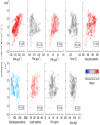Surface ocean microbiota determine cloud precursors
- PMID: 33431943
- PMCID: PMC7801489
- DOI: 10.1038/s41598-020-78097-5
Surface ocean microbiota determine cloud precursors
Abstract
One pathway by which the oceans influence climate is via the emission of sea spray that may subsequently influence cloud properties. Sea spray emissions are known to be dependent on atmospheric and oceanic physicochemical parameters, but the potential role of ocean biology on sea spray fluxes remains poorly characterized. Here we show a consistent significant relationship between seawater nanophytoplankton cell abundances and sea-spray derived Cloud Condensation Nuclei (CCN) number fluxes, generated using water from three different oceanic regions. This sensitivity of CCN number fluxes to ocean biology is currently unaccounted for in climate models yet our measurements indicate that it influences fluxes by more than one order of magnitude over the range of phytoplankton investigated.
Conflict of interest statement
The authors declare no competing interests.
Figures




References
-
- Glassmeier F, Hoffmann F, Johnson JS, Yamaguchi T, Carslaw KS, Feingold G. An emulator approach to stratocumulus susceptibility. Atmos. Chem. Phys. 2019;19:10191–10203. doi: 10.5194/acp-19-10191-2019. - DOI
-
- Rosenfeld, D., Zhu, Y., Wang, M., Zheng, Y., Goren, T., Yu, S. Aerosol-driven droplet concentrations dominate coverage and water of oceanic low-level clouds. Science363 (64276427) (2019). - PubMed
-
- Fossum, K.N., Ovadnevaite, J., Ceburnis, D., Dall’Osto, M., Marullo, S., Bellacicco, M., Simó, R., Liu, D., Flynn, M., Zuend, A., ODowd, C. Summertime primary and secondary contributions to southern ocean cloud condensation nuclei. Sci. Rep.8(11), 13844. 10.1038/s41598-018-32047-4 (2018). - PMC - PubMed
-
- Chubb T, Huang Y, Jensen J, Campos T, Siems S, Manton M. Observations of high droplet number concentrations in Southern Ocean boundary layer clouds. Atmos. Chem. Phys. 2016;16:971–987. doi: 10.5194/acp-16-971-2016. - DOI
Publication types
MeSH terms
LinkOut - more resources
Full Text Sources
Other Literature Sources

